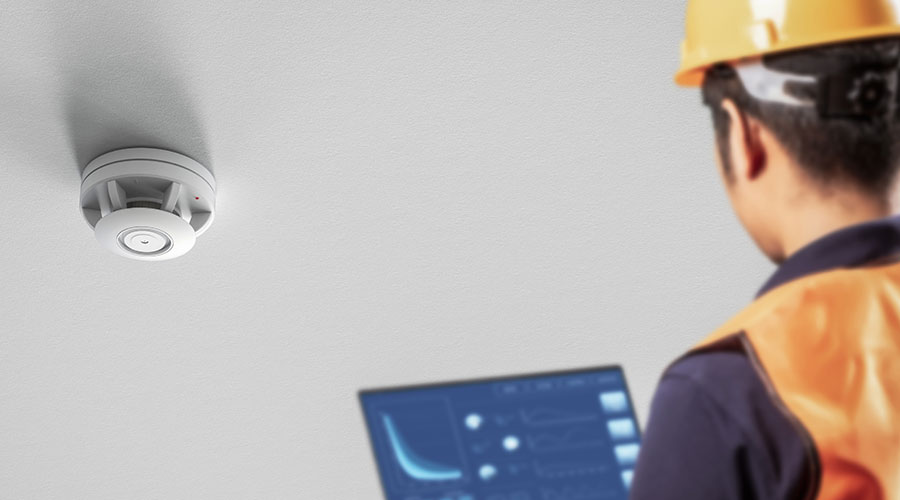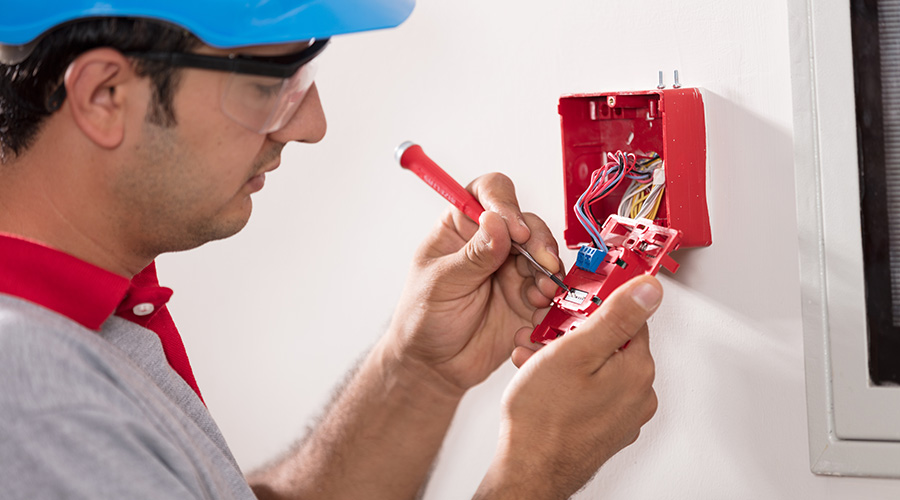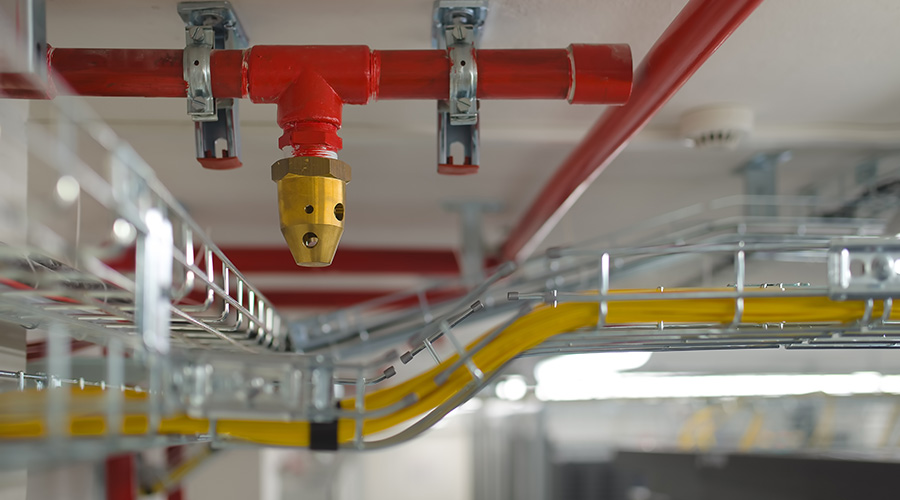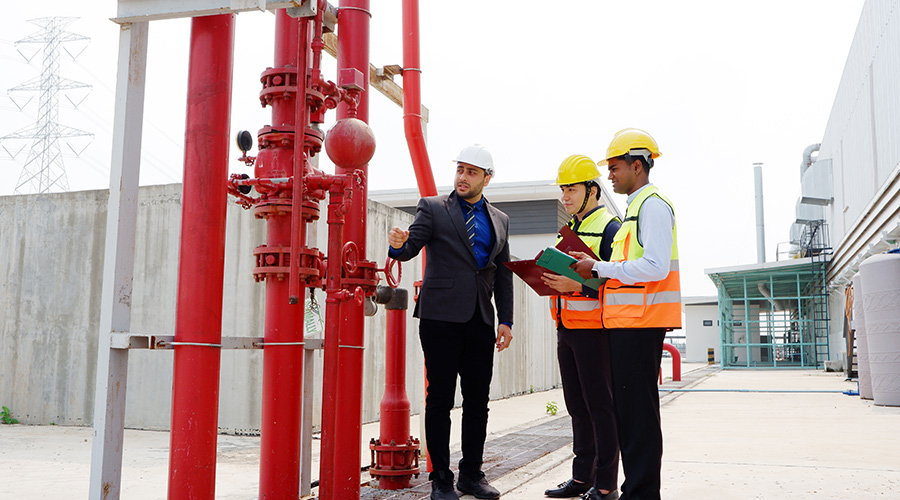Better Ways to Stop Fires
Recent developments in technology and design that can help prevent, detect and extinguish fires could improve the life-safety performance of buildings
Though it has been four years since the destruction of the World Trade Center towers, facility executives are just now beginning to see the long-term impact the disaster is having on building and fire safety codes and technologies.
In June, the U.S. Commerce Department’s National Institute of Standards and Technology (NIST) made recommendations to improve the safety of tall buildings, their occupants and first responders. NIST is a non-regulatory federal agency that, among other things, investigates major building failures. The agency also researches technologies to improve performance of structures.
The sweeping proposals result from the agency’s three-year inquiry into the fires and collapses related to the Sept. 11, 2001 terrorist attacks. Many of the changes call for wider use of technologies already on the market, but not yet widely deployed.
One recommendation calls for enhanced built-in fire resistance of structures during construction and for new methods of fire-resistant design. This includes wider implementation of performance-based designs for fire protection rather than reliance on prescriptive codes.
Performance-based designs focus on meeting fire and life-safety objectives for a given building rather than employing standardized designs mandated by code.
Performance-based codes
“Most codes prescribe how you design a system,” says Mills Puchovsky, principle fire protection engineer with the National Fire Protection Association. “Performance-based design doesn’t focus on that requirement, but instead focuses on the intent of the code. The purpose of performance-based codes is to make the system more effective, but you can use performance-based codes for different things, such as making the system more cost effective.” Because performance-based codes provide design flexibility, they can save time and money compared with prescriptive codes.
Performance-based systems can be beneficial, says Scott Grainger, president and chief engineer for Arizona-based Grainger Consulting. However, the downside could come years later if building use changes or if the building is altered. “Building owners don’t understand the impact of performance-based code work in the future,” Grainger says. “Performance-based systems make the building unique. If the facility executive doesn’t maintain and test the system, at some point it would come back to haunt them where all the cost savings would go away. If you use alternate methods, it affects that building from that point on. New owners may not realize that the building has different design codes. That would make changes far more difficult because the building has special rules that apply to it.”
Other NIST recommendations include more use of fire-resistant coatings and technologies during construction or renovation. These coatings, called flame reactants, can prevent fires from starting in the first place, says Ken Rusk, vice president of No Burn, a manufacturer of flame retardants.
Similar in texture and appearance to paint, these materials can be applied to almost any building material, including raw wood, drywall and steel. When heat hits the material, it swells to protect the structure underneath. It also removes oxygen from the fire and deflects the heat. A char barrier forms to prevent the fire from spreading.
Flame retardants also can be applied to the building’s contents, such as carpet, cloth furniture and curtains, and, in hospitality or health care facilities, mattresses.
Flame-retardant plastics, called FM4910 materials, are another type of technology. These plastics are common in clean-room construction and are becoming more sought after in food processing and pharmaceutical manufacturing, where damage from traditional fire suppression systems can be as devastating as fire itself, says Paris Stavrianidis, vice president and manager of FM Approvals, a nationally recognized testing laboratory.
These technologies don’t eliminate the need for active fire protection systems. In fact, systems like sprinklers and alarms should be enhanced to provide better performance, reliability and redundancy, the report says.
“For many years, NIST has worked on furthering and improving smoke detectors to try to minimize false alarms,” says Dan Madrzykowski, a NIST fire protection engineer who investigated the February 2003 fire at The Station nightclub in West Warwick, R.I., where 100 people died.
These improvements include voice annunciation systems and more sensitive monitoring devices.
Research shows that using multiple monitoring and detection systems improves the ability to determine whether an alarm really indicates a hazardous condition, Madrzykowski says. “This way, you have enough from different components to say whether this actually is a fire,” he says.
Open-path detectors, which monitor toxic gases, have become more sensitive as well. They can detect low concentrations at greater distances, giving facility executives and first responders more time to react.
Part of that response includes evacuating the building. Voice annunciation, or voice alarm, systems are becoming more widely deployed in high rise or large assembly buildings where the building typically is evacuated one floor at time, says Chris Jelenewicz, engineering program manager for the Society of Fire Protection Engineers.
“Instead of having a horn or bell, there are speakers that give voice direction,” Jelenewicz says. “The messages can be both automated and live human. The systems have pre-selected messages, but also have the capability to give specific instructions.”
Voice intelligibility is critical for these systems. System engineers are concerned that occupants will hear the alarm, but not understand what it is saying.
Once a fire has been detected, suppression is critical. New sprinkler head designs enable the system to respond faster, use less water and cover a wider area, reducing hardware costs, Jelenewicz says.
Water mist is another recent development in fire suppression, Stavrianidis says. Designed to reduce water damage, mist systems produce a fine spray that leaves little residual water.
Clean-agent waterless suppression systems can also reduce secondary damage, says John Schuster, business manager of clean extinguishing agents for 3M’s Electronic Markets Materials Division. Clean agents leave no residue and dissipate once the fire is out. These gaseous materials take the heat out of the fire, preventing it from burning.
Clean agents have been heavily researched since halon was banned more than a decade ago. The new class of clean agents is designed to provide the performance of halon without the environmental side effects. Unlike carbon dioxide systems, which will asphyxiate humans, these materials also are safe for occupants should they be unable to escape before the system discharges.
Clean-agent systems are more expensive to install and maintain than water systems, Jelenewicz says. They are most often used in telecoms, data centers and other spaces where water damage costs outweigh system costs.
Communication is key
Fire suppression isn’t the only important component of fighting a fire. Increasingly, firefighters are finding it imperative to communicate with the building itself. For this reason, the NIST report also calls for more communication with building systems that can provide continuous, accurate information on life safety conditions. These systems should be able to deliver to emergency responders real-time data from fire alarms and other building systems. The systems should also be able to preserve data for later investigation either by remote monitoring or in a fireproof black box.
One NIST-developed technology now on the market is the “smart” fire alarm control panel, Madrzykowski says. Historically, fire alarm panel icons differ by manufacturer. Firefighters had to decipher what the panel was telling them or ignore it.
The smart panel standardizes icons so firefighters can immediately recognize their meanings.
New panels also provide more information. For example, they can show floor plans, elevations and systems that have been activated. They might show that a fire pump is running in one section of the building but not in another, indicating that the fire might be confined to a given area.
“Now with more sensors and better ways of getting data out, the smart panels provide more meaningful information,” Madrzykowski says.
Disseminating information
NIST also is working with the National Electric Manufacturers Association to find ways to get the information out of the building and into the hands of firefighters before they go inside, Madrzykowski says. The communications system would tell firefighters what kind of equipment is installed and where it is located. It also would communicate alarm panel information to help responders determine whether the fire is changing or growing. This data would help first responders quickly determine what resources are needed on the scene, says Ofer Azoulay, chief executive officer of SFW, a developer of asset management and tracking tools.
Without that sort of information, firefighters have no way of knowing what is happening inside a building.
“If the condition is not changing, it’s probably a small fire,” says Madrzykowski. “If you had one smoke detector going off initially, but now they’re all going off, that’s a good indication smoke is filling the building. You know you need more hands, and you can get more help sooner.”
These new communications systems, which already are coming to market, can provide a central source of information for facility executives and emergency personnel.
The NIST report also calls for better system designs that facilitate safe and rapid egress of occupants while accommodating the counterflow of emergency personnel. The report also calls for more study into elevator hardening, exterior escape systems and stairwell navigation devices.
“There are cases where people used elevators and got out safely,” Madrzykowski says. “There are many reasons to consider elevators for evacuation. We are trying to address the technical and procedural use of elevators for evacuation and ensure safety for first responders — like a special elevator that could be fire- and smoke-hardened with concrete.”
The elevator issue is particularly important for people with disabilities. While a safe area of refuge could be engineered for people with disabilities, people don’t want to leave other people behind, Madrzykowski says. “That calls for an elevator driven safety egress.”
For existing facilities, the report advocates the adoption and application of new egress and sprinkler code requirements. The movement is particularly strong in buildings such as college dormitories and health care facilities, says Tom Chapin, fire safety strategic business unit general manager for Underwriters Laboratory (UL).
Training required
The sophistication of the new technology requires more advanced training for installation and maintenance technicians as well as code enforcement inspectors. Unfortunately, much of this training isn’t happening.
“There’s a lot of neat, new technology, but when they are put into practice, building owners aren’t up to speed,” Grainger says. If the new technology isn’t properly installed and inspected, it may fail.
After the upgraded systems are installed, facility executives must know exactly what they have so that they know what to ask for in terms of maintenance and inspection work. If the systems are not adequately maintained, building owners could “become partially liable,” he says.
UL is making it easier to determine whether equipment is suitable to an application with three new approval marks, says Chris Hasbrok, UL strategic business unit general manager. The marks apply to security equipment, signaling equipment and commercial security equipment.
“Some new technologies enhance each other. Some don’t,” he says. “The new marks were introduced to differentiate for authorities equipment performance capabilities.”
While the World Trade Center certainly is a catastrophic example of why newer, more advanced fire and life safety systems are critical, it certainly isn’t the only reminder. Fire statistics should be all the motivation a facility executive should need, Chapin says.
In 2004, there were 115,500 nonresidential structure fires according the NFPA’s annual National Fire Experience Survey. Those fires resulted in 80 deaths, 1,350 civilian injuries and more than $2.3 billion in property damages.
New technologies offer one way to reduce those losses. But it’s more important to make sure that systems in place work. “Facility executives must understand their particular systems,” Puchovsky says. “They need to have a good maintenance system in plan to ensure that the system operates when called upon.”
Lynn Proctor Windle, a contributing editor to Building Operating Management, is a freelance writer who has written extensively about real estate.
Related Topics:











